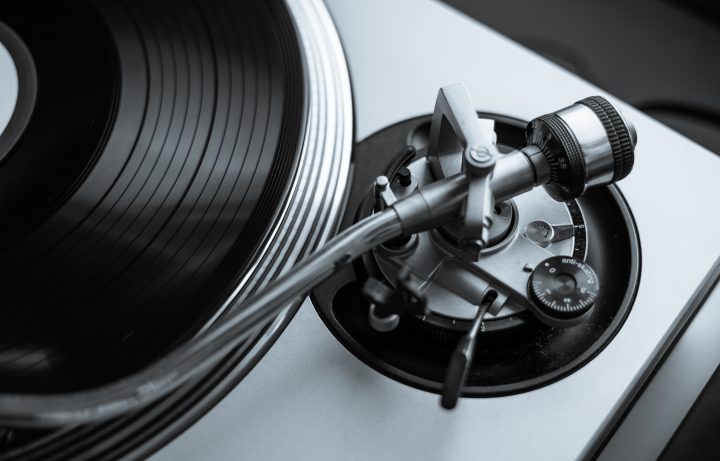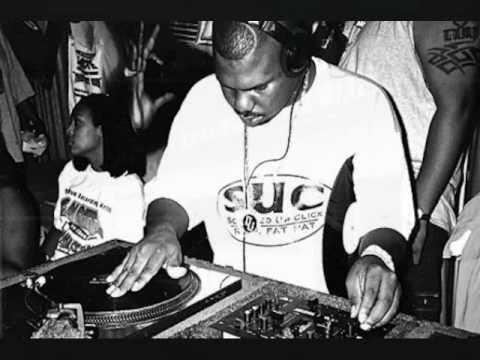Unsure what the anti-skate feature on turntables does? What does it mean for a turntable to be an anti-skate turntable? And what about tracking force? Why is anti skate necessary?
All this and more today as we explore some of the burning questions around anti-skate and tracking force on your turntable, as well as how you might go about adjusting it for yourself.
Table of Contents
- What Is Anti-Skating?
- How Can Anti-Skating Impact Your Sound Quality?
- Anti-Skating vs Tracking Force
- How to Setup Anti-Skating Yourself
- Final Tones
- FAQs Anti-Skate Turntable

What Is Anti-Skating?
The term anti-skating refers to a function of the turntable that attempts to prevent the stylus from skating all over the disc.
Now, we obviously do not mean that the stylus will suddenly put on a bunch of Supreme merchandise and start doing kickflips and ollies all over the record. Skating in the context of turntablism and audiophilia instead refers to the action of the stylus veering off its course.
This can be rather dramatic, wherein a stylus is quite literally being bucked all over the disc like a cowboy on a bronco. This can also act in subtler ways that even a seasoned record collector might not notice as much, where the left and right channels are imbalanced somewhat.
On each side of a record’s groove is imparted sensitive vibrational data, that for the left channel on one side and the right channel on the other side. If the stylus is veering too far to either side, then it stands to reason that there will be an imbalance in the stereo field, either the left or right channel receiving too much attention.

An anti-skate feature on turntables is one that is equipped to deal with this problem, installed with the anti-skating force to tackle this issue head-on. You can be sure that a turntable featuring an anti-skating feature is designed to allow you an utterly customizable experience that is also free from issues.
Since the disc is spinning and slowly drawing the stylus forth, there is always going to be a force of this kind guiding all atop the tonearm toward the center. An anti-skate feature on turntables simply means that control can be exercised judiciously.
How Can Anti-Skating Impact Your Sound Quality?
As we have already seen, the impact of this skating pest can be enormous, much as many of the older generations believe skateboarding to be on society at large. Likewise, though, the effect can also be very minimal.
It is this latter variety that is perhaps the greatest scourge. Since it can come in covertly, even to the point where a seasoned record collector might not notice it, then it can continue to do untold damage to your records without your realizing it.
If, for example, a stylus is veering ever so slightly too far to either the left or right side of the groove (and thus of the stereo field), then it is impressing itself harder on one side than the other. Sure, playing records is inherently damaging to them, but skating in this way can act as an accelerator of a record’s already limited lifespan.
This is why having an anti-skating adjustment installed on your turntable is of the utmost importance – if you value your records, of course.
When properly calibrated, the anti-skating track will perfectly trace itself along the record groove without a hitch, ushering forth a dynamic sound with good channel balance that is free of distortion.
Of course, it is all too easy to use this mechanism improperly, placing too much on the adjustable weight and thus placing an unequal force on the tonearm. This will put excess pressure on the record and will not only damage it in the long term but will also result in a poor listening experience in the short term.
Indeed, such measures can result in very obvious distortions in the sound, just as a lack of weight on the anti-skating mechanism can result in the stylus jumping about all over the place. Record player sound distorted? It could very well be because of this.
Anti-Skating vs Tracking Force
These two terms are often used interchangeably in discussions of this kind, even though they refer to two separate parts of a turntable.
It is true that each part does work together to ensure records are played at the optimal sound quality. Still, they do perform separate functions that it would be best to enlighten ourselves upon.
So, while the anti-skating force is attempting to control the action of the tonearm as it veers toward the center of the record, what exactly is the tracking force up to?
Glad you asked. The tracking force is essentially working to apply the right amount of vertical tracking force (or pressure) to the record. Too little, and the record simply will not sound very good, and the stylus might jump about all over the place. Too much, and the record will also not sound very good, and the stylus will likely do some serious long-term damage to the record in question.
In order to set the tracking force properly, you ought to refer to the specific instructions that come along with each separate cartridge stylus. The exact measurement will vary depending on which cartridge you are using and from whom you purchased it, so adjust according to these instructions.
Thankfully, both the anti-skating measures and the tracking force inform each other on a deep level. By setting your anti-skate measurements properly, you will also be ensuring that the tracking force can more accurately perform its duties. And you can always try, say, the Audio-Technica or Ortofon website for the information you need, if indeed you use cartridges by those manufacturers.
Setting these things up properly is also a lot easier than all of the adulterous jargon would have you believe. The anti-skate feature on turntables simply counterbalances the tracking force and uses these same settings in order to achieve its own right balance of pressure on the inner grooves of your vinyl records.
How to Setup Anti-Skating Yourself
So, let us put all of this jargon into practice and show you how you go about setting up the anti-skating feature on turntables.
Step 1: Balance the Tonearm and Set the Tracking Force
First up is this essential preparatory step. Before you proceed onward, you must ensure that you have properly balanced the tonearm. Thankfully, most decent turntables come with an adjustable weight on the opposite end of the tonearm called a counterweight which can help account for variations in the cartridge.
Start with the counterweight and the anti-skating at 0, then adjust your way with the counterweight to a point where the tonearm is floating freely. Congratulations! The tonearm is now rightly balanced.
Now, to adjust the tracking force, you must rotate the knob on the counterweight until it has reached the weight that the cartridge manufacturer has recommended in the instructions. If you have since lost these instructions or do not like the man telling you what to do, then a safe bet is to set it around 2-3 grams.
Step 2: Calibrate the Anti-Skate Feature on Turntables
Now that you have properly adjusted the tracking force (and only after you have done so), you can proceed to adjust the anti-skate feature on turntables.
Most modern turntable systems will include a knob or slider of some sort that can be adjusted relatively easily, either with a screwdriver of your own, one that they have included, or even just your fingers.
If you are going to use fingers, though, make sure that you have unplugged the turntable first. This goes for anything electrical, really. The shock might not be great, but crazier things have happened than a freak jolt of electricity that does a little more than just shock.
No matter how you go about it, you will then want to match this adjustable anti-skate measure to the tracking force. Experiment with the knob or slider until it more or less resembles the reading that you used on the tracking force.
So, if the tracking force you are using is, say, 3 grams, then you will also want it so that the anti-skating force is set to 3 grams. Matching them in this way ensures that they are as in sync as they ought to be. The tracking force and anti-skate feature on turntables are, after all, symbiotic pairs.
Now that you have properly set the tracking force and anti-skate up as described, you can go on ahead and give it all a try. Remember, there is no need to panic if your turntable is suddenly not spinning. Chances are you simply forgot to plug it all back in again.
Go forth and check the quality of the audio when played back by picking a record that you know well enough to tell if there are any abnormalities in the turntable during playback.
If you are still experiencing issues, then simply go back and repeat the steps until it sounds as you would like them to. This is a perfectly normal part of the process, and it is precisely this attitude of trial and error that will enable you to get your settings just right for you.
There are more turntable models and varieties out there than ever before, and yet every single turntable is still unique in its own way. What works perfectly for one might not work as perfectly for another. Thus, it is best to feel it out for yourself rather than going by some theoretical metric.
Final Tones
So, there you have it. Hopefully, you are now more clued in about the anti-skate feature on turntables and how does anti skate affect sound. Ensure to follow all the steps above, as they will show you the way how to tell if anti skate is working. Until next time!
FAQs Anti-Skate Turntable
What does the anti-skate feature on turntables does?
The tonearm on a turntable is constantly at battle with a number of different forces. One of them is gravity, and its effect on the proceedings is controlled with a tool called tracking force which controls the amount of pressure exerted on a record’s grooves by the stylus. Another of these central forces is skating a tertiary motion that, by a tonearm’s inherent tendency to veer towards the center of a record, can also cause the stylus to do the same. This is force is combatted with anti-skate measures, which seek to balance the force of the tonearm and stylus as they veer toward the center of the record.
What should your anti-skate be set to?
The specific settings of both anti-skate measures and tracking force do not have one holistic metric but rather should be adjusted to individual circumstances. The tracking force should be set to whatever the manufacturer of the cartridge recommends in its instructions. If you have lost these instructions, then a safe bet is to go between 2 and 3 grams. The anti-skating force is closely matched with the tracking force, and so you can safely match the measurements on both without worrying that you are doing the wrong thing.
What happens if the anti-skate feature on turntables is too high?
Skating is a force that acts upon the proper functioning of a turntable by beckoning the tonearm and stylus to abandon their duties and play foolishly amongst the grooves. This can have more severe implications, such as when a stylus skips and jumps all over the place, or these effects can be more subtle, such as when a stylus veers too far to one side of the stereo field. Anti-skate measures help to alleviate these problems, though they can cause just as much harm if not calibrated properly. Indeed, if the anti-skate feature on turntables is too high, then the stylus might just as well veer too far the other way, causing more harm to the opposite side of the groove and, thus, the stereo field.





